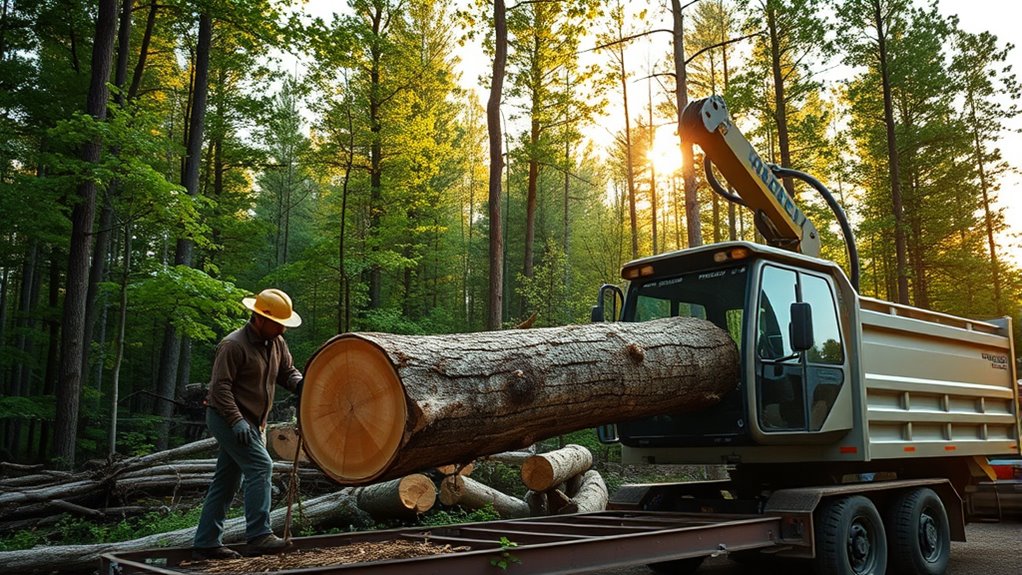Sustainable wood harvesting allows you to heat your home with renewable resources while protecting forests and reducing your carbon footprint. By following responsible forest management and using renewable sourcing practices, you help guarantee forests can regenerate naturally and stay healthy. These methods support ecological balance and promote long-term environmental benefits. If you want to learn how responsible harvesting practices contribute to a greener, climate-friendly future, there’s plenty more to explore.
Key Takeaways
- Sustainable wood harvesting ensures a renewable supply that minimizes environmental impact and supports carbon-neutral heating goals.
- Proper forest management maintains ecosystem health and biodiversity while allowing responsible wood extraction.
- Replanting and natural regeneration after harvesting sustain forest growth and carbon sequestration capacity.
- Using sustainably sourced wood reduces reliance on fossil fuels, lowering overall carbon emissions for heating.
- Adhering to sustainable practices helps prevent deforestation and habitat loss, promoting long-term ecological balance.

Have you ever wondered how we can enjoy the benefits of wood without harming our forests? The key lies in sustainable wood harvesting, which depends on effective forest management and renewable sourcing. When you choose wood products or heating options that prioritize these principles, you actively support the health of our forests while reducing your carbon footprint. Forest management involves carefully planning and overseeing how trees are harvested to ensure the forest’s ecosystems stay balanced and healthy. It’s about more than just cutting trees; it’s about maintaining biodiversity, protecting soil and water quality, and ensuring future growth. When done responsibly, forest management helps forests regenerate naturally and prevents overharvesting, which can lead to deforestation and habitat loss.
Renewable sourcing is a fundamental part of sustainable wood harvesting. It means that the wood you use comes from sources that can replenish themselves over time. Forests are renewable resources when managed properly, so as long as new trees are planted or allowed to grow naturally after harvest, the cycle continues without depleting the forest. This approach contrasts sharply with unsustainable practices that deplete resources faster than they can recover, leading to long-term environmental damage. By supporting products from renewable sourcing, you’re helping to create a market that values and incentivizes responsible forest practices. This approach encourages forestry companies and landowners to prioritize sustainable methods, such as selective harvesting and replanting initiatives.
Choosing wood from sustainably managed forests ensures that your heating system or building materials are aligned with environmental goals. It’s not just about reducing emissions; it’s about actively participating in a cycle that benefits the planet. When you opt for wood sourced through certified sustainable practices, you’re promoting responsible land use and resource conservation. This choice helps maintain the ecological integrity of forests, ensuring that they continue to sequester carbon, support wildlife, and provide clean air and water. Furthermore, renewable sourcing reduces the pressure to convert forests into other land uses, such as agriculture or urban development, which often have more severe environmental impacts.
In essence, sustainable wood harvesting combines the principles of forest management and renewable sourcing to secure a reliable, eco-friendly fuel source. It makes it possible for you to enjoy the warmth and comfort of wood heating while actively protecting forests for future generations. By supporting responsible forestry practices, you help foster a sustainable cycle where forests thrive, carbon is stored, and the environment remains balanced. This approach turns wood into a truly renewable resource—one that can contribute to a greener, more resilient planet. Proper forest management practices ensure that sustainable harvesting methods are followed, further supporting environmental health and resource renewal.
Frequently Asked Questions
How Does Sustainable Harvesting Impact Local Biodiversity?
When you practice sustainable harvesting, you positively impact local biodiversity by supporting biodiversity conservation and habitat preservation. You guarantee that only mature trees are harvested, allowing younger plants and diverse species to thrive. This careful approach maintains ecosystem balance, protects habitats for wildlife, and promotes a healthy, resilient environment. Your efforts help prevent habitat destruction, ensuring that biodiversity remains rich and diverse for future generations to enjoy.
What Certifications Ensure Responsible Wood Sourcing?
You can trust certification standards like FSC and PEFC to guarantee responsible sourcing. These certifications verify that wood comes from sustainably managed forests, protecting biodiversity and supporting responsible harvesting practices. When you choose products with these labels, you’re helping promote environmental stewardship, fair labor practices, and sustainable forestry. Always look for these certifications to ensure your wood supplies are responsibly sourced and contribute to a healthier planet.
How Can Consumers Verify Wood Is Sustainably Harvested?
You can verify wood is sustainably harvested by checking for wood traceability, which tracks the product from forest to your home. Look for labels or documentation indicating responsible harvest practices, such as FSC or PEFC certification. Trust sources that provide transparent information about their supply chain and harvest practices. This guarantees you’re supporting sustainable forestry and reducing environmental impact while enjoying your heating.
What Are the Long-Term Effects of Sustainable Harvesting on Forest Health?
You’ll find that sustainable harvesting benefits forest health by promoting forest regeneration, ensuring trees can grow back and maintain biodiversity. It also supports soil preservation, preventing erosion and nutrient loss. Over the long term, these practices help forests stay resilient, adapt to environmental changes, and continue providing essential ecosystem services. By choosing sustainably harvested wood, you contribute to healthy, thriving forests that sustain both wildlife and future wood supplies.
How Does Sustainable Harvesting Compare Economically to Conventional Methods?
Sustainable harvesting often proves more cost-effective over time because it minimizes environmental damage, leading to lower reforestation costs. You benefit from long-term stability, as healthy forests ensure consistent wood supply. Additionally, sustainable methods enhance market competitiveness by appealing to eco-conscious consumers and complying with regulations. While initial costs may be higher, the overall cost benefits and the positive reputation bolster your economic resilience in the long run.
Conclusion
By choosing sustainable wood harvesting, you help protect forests and support carbon-neutral heating. Imagine a community that carefully manages its forests, regularly planting new trees after harvesting. This approach guarantees a continuous supply of wood while reducing carbon emissions. For example, in a small Scandinavian town, sustainable practices have kept their forests healthy and provided reliable heating for decades. You can make a difference by supporting and advocating for responsible wood use today.











